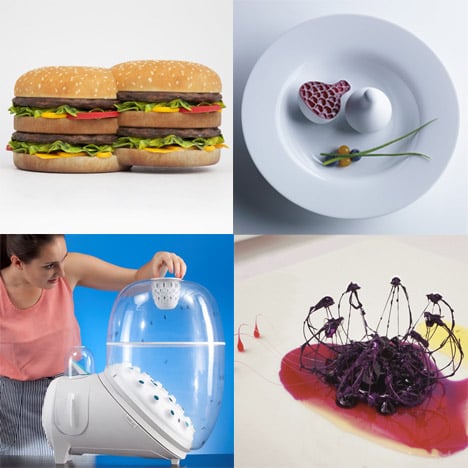Following our recent story about an insect-breeding gadget for the domestic kitchen, here's a look back at some of the most bizarre designer food concepts from our archives, including 3D-printed burgers and wriggling snacks.
"By 2050 meat production will have to increase by 50%," states graduate designer Katharina Unger. "Considering that we already use one third of croplands for the production of animal feed, we will have to look for alternative food sources and alternative ways of growing it."
Her solution? To breed insects in a table-top farm at home and serve up the larvae, which she says tastes "nutty and a bit meaty", as an alternative source of protein.
Unger isn't the only designer suggesting alternative options to everyday cuisine: we interviewed designers about the future of food for an article in our one-off 3D printing magazine Print Shift.
Included in the feature was a machine that prints combinations of ingredients into shapes and consistencies specified by the user, imagined by Philips Design in 2009.
Philips Design also developed a farm for the living room."People are increasingly concerned about how their food has been manipulated and processed, genetic modification, global shortages, environmental degradation through monoculture, the distance food travels before reaching their plates and many other related issues," said Clive van Heerden, the company's senior director of design-led innovation.
More recently, 3D printing pioneer Janne Kyttanen created prototypes of 3D-printed burgers and pasta to demonstrate how the technology could be used in the future.
"I printed burgers just to create an iconic image and make people realise that one day we will be able to 3D-print a hamburger," he told Dezeen. "Once you do, you don’t want to print a traditional hamburger; you can print the weirdest thing you can imagine."
- The Sugar Lab by Kyle and Liz von Hasseln
There's already demand for superficial uses of 3D printing technology, such as 3D-printed sugar sculptures for wedding cakes, table centrepieces and pie toppings created by Los Angeles company The Sugar Lab.
Other designers are simply experimenting with the way we react to food, or the way food reacts to us. "What if food was able to play with our cutlery and create hyper-sensations in our mouth?" asked Minsu Kim, whose Living Food project uses synthetic biology to propose meals that wriggle on the plate and in the mouth.
If you don't like the sound of that, how about edible furniture or edible lighting?
See all our stories about food »

